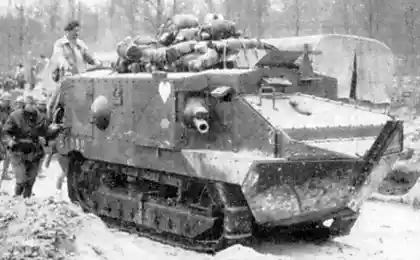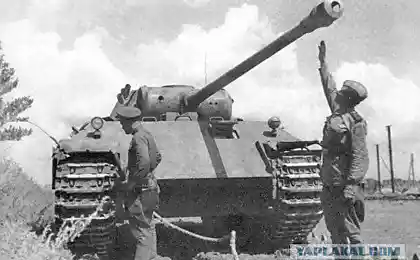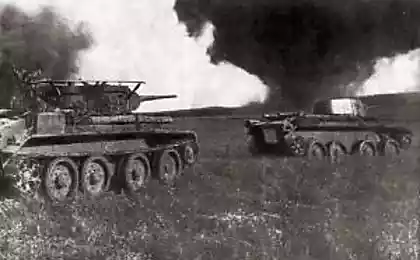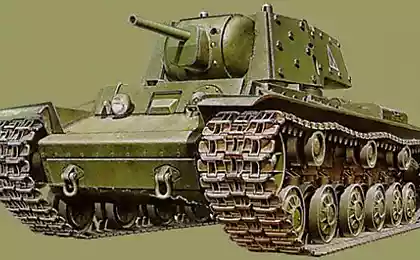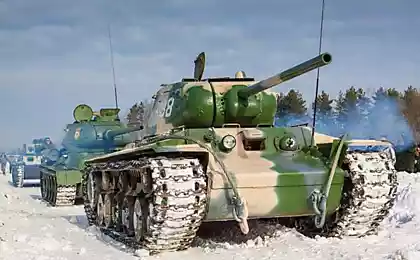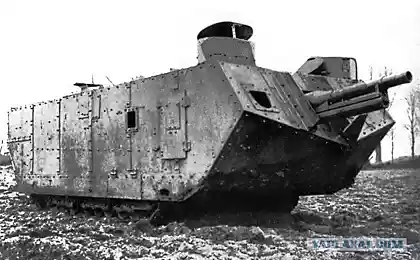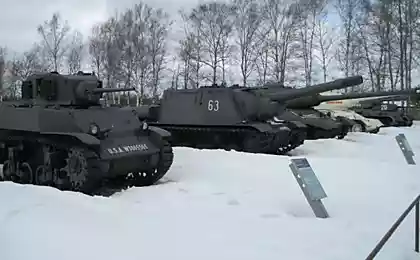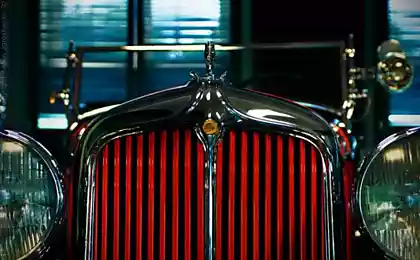1107
Imperial War Museum (Tanks)
1 In my opinion, the Imperial War Museum (Imperial War Museum) is one of the most fascinating in London, though pacifists with me, of course, disagree. Exhibits include his military conflicts since the beginning of the XX century and modern times.
The museum was conceived as early as 1917 - in the midst of the First World War, to pay tribute to the participants of the grandiose slaughter and home front workers. The opening took place in the summer of 1920 in the Crystal Palace. Then, the museum has several times changed his residence, until in 1936 finally settled in a former Betlemske psychiatric Royal Hospital (which is well known as "Bedlam") on Lambeth Road, which, incidentally, has saved the real palace of the plan was the demolition .
Although the museum was closed to the public since 1940, and another year later was struck by a direct hit of German bombs, the materials on the Second World War, there began to collect almost immediately after it began. Partially renovated museum opened to visitors in 1946 and continued to aggressively create new and new exposure associated with practically every more or less large military conflict, especially if it somehow related to the UK or the members of the British Commonwealth. Do not forget the Cold War, which is dedicated to the former Bedlam than one room.
Photos I have done so much, that the album of the Imperial War Museum will have to beat a dozen pieces. However, we wait and see - if the topic is of particular interest in the cause, the story can always fold. Well, in the first part of the album, I will highlight the theme mainly exposed in the huge main hall of the museum of armored vehicles. Later, through a miniature submarines, missiles and artillery'll move to the air, and then to the trenches of the First World War and to the image of Russian allies, what they depict contemporary British public. Well, we'll see - how the suit will fall. Post, however, still have a hanger, or rather to the main entrance of the museum, which will inevitably have to go through before get the exposure to the tank.
In magnificent building built in the early XIX century visitor encounters a very impressive offshore raspaltsovka 15-inch (381-mm) guns of the century XX.
20 Picchu text. via dkphoto

2 These monsters were designed in 1912 for class battleships "Queen Elizabeth» (Queen Elisabeth), and at that time was the most powerful in the world (then they certainly exceeded). Total such guns was armed with 22 British battleships. The weight of each "baby" is 102 tons, maximum range up to 29 kilometers. Most heavy shell - for the sake of clarity, it is possible to admire on the right - weighs 876 kilograms. The effect of falling into the enemy ship, you can only try to imagine. However, artillery fire at that time are not particularly accurate.
Exposed front of the museum guns served on different ships. What adorns the left, in 1916, was installed in one of four twin towers battleship 'Ramillies »(HMS Ramillies) Class" Revenge »(Revenge, aka Royal Sovereign), which is a further improvement" Queen Elizabeth. " Baptism of fire weapon received after the end of the First World in the relatively little-known second Greco-Turkish War 1919-1922 years. In 1920, during an exacerbation of the conflict between Britain (Allies formally supported the Greeks) and Turkey battleship shelled shore targets in the Sea of Marmara.
The second and last time the gun had a chance to shoot at the enemy in November 1940, mainly in the inconclusive battle with the Italian fleet at Cape Spartivento. Also mentioned are some attacks on targets on land in the same month, but what exactly is it, I have not found. Anyway, next year the gun was dismantled.
Cannon, standing right, fought much longer, though, and began his career in much the same - the same type on board the battleship "Rezolyushin» (HMS Resolution) during the Greco-Turkish War. However, shooting battleship then and did not have to - it is only the sword of Damocles plied the eastern Mediterranean.
In 1938, an instrument was dismantled from the battleship, but with the beginning of World War II, construction was set to monitor "Roberts» (HMS Roberts). And it is here that the work was found! Operation "Torch" (Allied landings in French North Africa), the operation "Husky" (invasion of Sicily), the operation "Avalanche" (the landing at Salerno, Italy) - it was only a prelude to a genuine work during the Allied landings in Normandy. Monitor suppress their fire German coastal battery in Houlgate, I kept shelling the positions of the Wehrmacht at Cannes. Later on November 1, 1944 implements "Roberts" kept landing on the Dutch island (peninsula) Walcheren, shooting a German artillery position near the village of Westkapelle.
Immediately after the war there put up a weapon was dismantled.
His last duty station at the entrance to the Imperial War Museum, these menacing pipe found in 1968.

3 Visit to the museum is free for all - as has become a tradition ever since its opening. The institution is funded primarily by the state. Apparently, the museum (quite justified, I want to mention) is considered an important element of patriotic education. The educational function is realized already located at the entrance kinozalchike where on a big screen showing films about British peacekeepers in different corners of the world. Frankly, although I was interested in references to Iraq and Yugoslavia, to linger at the screen did not - hurried to the main exhibition. Meanwhile, it is curious that the film tells of Tony Blair and the invasion of Iraq, of the Serbs and Albanians ...

4 The most delicious in the museum - it is a multi-storey main exhibition hall where the real military equipment: tanks, self-propelled guns, towed artillery systems, fighter jets, bombers, cruise missiles and ballistic missiles, submarines and other samples of the old martial iron. As I announced above, the story will begin with armored subjects.
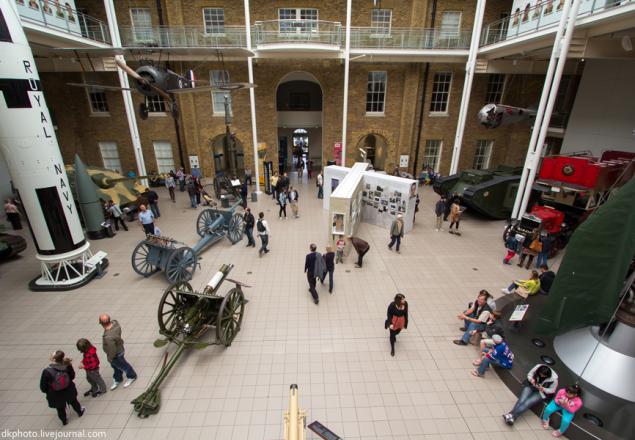
5 interesting exhibits - a heavy British tank of the First World War, Mark V (Mk V). Despite the impressive weight of nearly 30 tons, it can not boast of any heavy armor - in this sense it does not exceed, and taking into account angles inferior plane of the body, even the earlier French light tank Renault FT-17. The thickness of the frontal armor of the giant does not exceed 15 mm, which effectively protects only against small arms fire and shrapnel.
The advantage of the heavy tank was then considered his firepower. Mark V in the exposed then modifying "male" ("female" were purely machine-gun armament) could boast two maritime rapid-6-pound guns "Hotchkiss" (caliber 57 mm, barrel length of 40 calibres) in two sponsons and four 8-mm machine guns "Hotchkiss" with air cooling.
The speed of this giant on the highway does not exceed 7-8 km / h and on the road was several times lower, which, coupled with a small reserve is not allowed to use these tanks to develop after the onset of the breakthrough - he usually managed to bring up reserves and to localize the gap .
Tanks Mark V compared to its predecessors, however, considered to be very sophisticated. In part, they were only in May 1918, and the fight went and did in July, that is the end of the war, of the Great War. Exhibited machine here at number 19 and the name 'Devil' serve in the fourth battalion of the Royal Tank Corps. Tank was decommissioned in 1925. The Red Army seized from the white invaders and Mark V poverty were armed at all until 1930, but under the name "Riccardo" by brand engine.
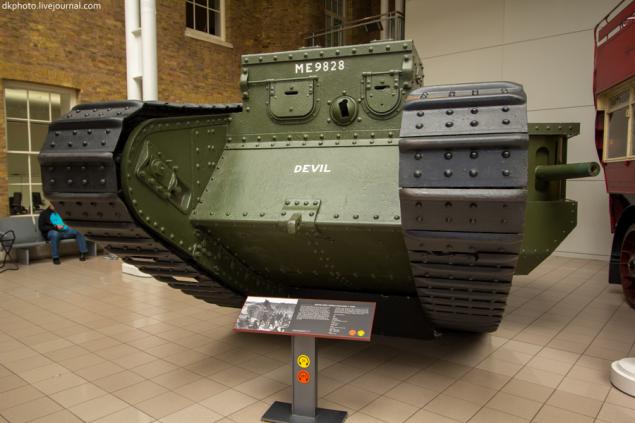
6 For clarity and convenience of visitors to the museum one sponson the tank removed and taken away through a hole in the glass, you can see the interior of the machine. Exceptionally good idea!

7 Mark V crew consisted of eight people, while significant progress was thought that to drive a car could now only one member of the crew - a driver. Prior to that, the British heavy tanks require considerable joint efforts of four people at once: the actual driver, the commander in charge of the brake tracks both sides, as well as two transmissionschikov working for airborne transmission. Coordination of actions hampered the infernal noise of the set in the center of the inner chamber of the engine and propeller unmerciful clang elements, not to mention the work of the weapons. Meanwhile, an internal intercom system in the tanks of the time just was not there. With external communications business situation was also very badly - at short distances using flag signaling and for communication over long distances tried to use carrier pigeons. However, quite unsuccessfully, as the poor bird could not withstand the conditions inside the tank.
Said noise was flowers compared to the high temperature air (during the fight, it rose to 70 degrees) from the heating of the engine, a child of the hot oil and smoke from the cannon shots (to purge the barrel after shooting began only during the Second World War, and then not at all tanks). In such circumstances, the crew often simply ugoral in the midst of battle.
Poor was the observation of the tank - the cracks did not give a good review, but they were aiming arrows of the enemy, and even if the bullet hits nearby, often flew into a spray of molten lead. That is why 80% of all tankers had wounds to the eyes. However, a Mark V viewing device of the driver represented a perforated plate, and somehow protect the eyes.
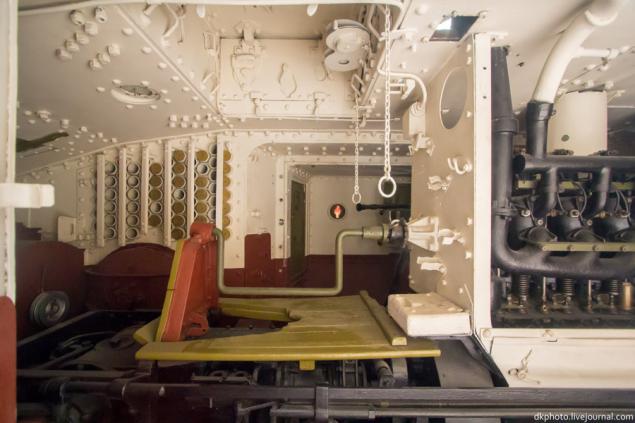
8 Easy armored Daimler Mk I (Daimler Armoured Car), after some thought, I have also included in the Tank section of the Album. This 7, 5-ton all-wheel drive car was the basis for the armored car and parts of British intelligence during World War II. In the light of it appeared in April 1939, but because of the many technical problems that required fixes her military career really began only in 1941. There were produced 2694 cars Mark I and Mark II.

9 Maximum armor thickness reached 36 mm, and installed a tower on a light tank "Tetrarch" with its relatively good arms (2-pound cannon and 7 62-mm machine gun "Besa") did Daimler Mk I quite dangerous opponent light of German and especially more Italian tanks. However, the creators of the machine more relied on her mobility than security - armored car developed a speed of 80 km / h. The crew consisted of three people.
These armored cars were on different fronts of the Second World War (especially widely used in North Africa), and a long time afterwards. The fate of the exposed specimen caught in a museum only in 1966, is unknown. Damage camouflage corresponds to the first Royal Dragoons during the landing in Sicily in September 1943.

Legendary 10 at the time the average British infantry tank "Matilda» (Matilda II). Famous for it was mainly his colon - forehead 78 mm, 40-65 mm board - armor, which were powerless against the standard German anti-tank guns of the initial period of the war. This quality will bring a lot of trouble Rommel, until he used against tolstobronnyh but slow (15 km / h cross country, no more than 24 - on the highway) and inflexible used British command "Matilda" their small 88-mm anti-aircraft gun Flak 18 / 36/37.
Armament, by the way, was not adequately protected (it is believed that the tank should be able to destroy his own kind at a distance of over 500 meters) - a very weak 40-mm 2-funtovka as those shown above, the armored car.
These tanks are supplied under Lend-Lease and the USSR (900 pieces), but the Red Army did not enjoy great popularity, despite the greater comfort for the crew than the T-34.
Here, "Matilda" is presented in a desert camouflage for North Africa.
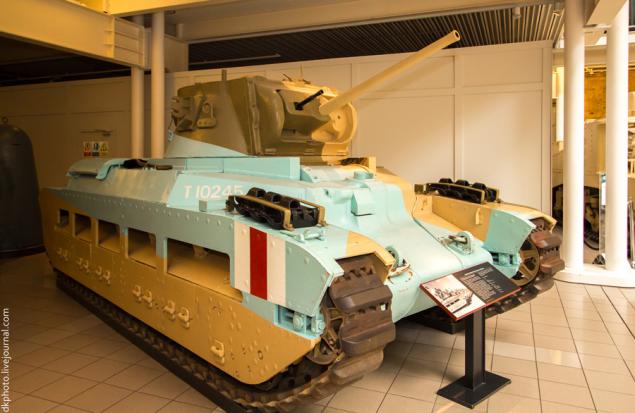
11 The average American tank M3A3, produced for the British army and bearing the name "Grant» (Grant). Supplied under Lend-Lease to the USSR, the tank was another unofficial name - BM-6, which stands for "mass grave for six." Do not loved in the Red Army lendlizovkie tanks, as they, in spite of the high culture of production of combat characteristics markedly inferior to the Soviet "classmates».
M3 - is hasty improvisation on the basis of a medium tank M2, produced at the beginning of the war, when the US government realized that the American army has nothing to oppose the German panzer divisions. Placing 75-mm guns in the side sponsons - a tribute to the tanks of World - has hindered the effectiveness of combat vehicle, which in other circumstances would not be carried to the tanks and to the ACS. (However, there was another 37-mm anti-tank gun in the tower, but it had originally been obsolete.) The second was the use of improvised propulsion system of several automobile engines. "Road" approach, however, has allowed American industry very quickly master the production of military equipment.
Despite all its shortcomings, M3 fared well in North Africa in a collision with the German Pz. IV, short-armed 75-mm cannon. Yet tank hopelessly outdated in the summer of 1943, when the Germans began to make extensive use of a new generation of their tanks, including "Tiger» Pz.VI and "Patnery» Pz.V. With the production of M3 was withdrawn, however, only in March 1944.
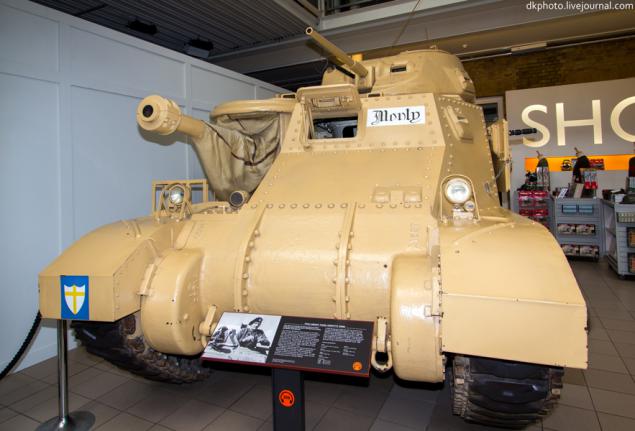
12 In the absence of the breech gun in the turret, is easy to guess that this modification of the commander, where the 37-mm gun for the exterior masking replaced hoax. In fact, the exhibition at the Museum of the sample served as commander of the machine General (later Field Marshal) Bernard Law Montgomery (Bernard Law Montgomery) (1886-1976), who broke the course of the war in North Africa and defeated one of the most talented German commanders - Erwin Rommel. For the British the battle of El Alamein the fall of 1942 as symbolic for us the battle of Stalingrad, though the magnitude (and significance, perhaps) to compare these battles, of course, impossible.

13 heavy infantry tank "Churchill» (Cherchill) Mark VII - is also a kind greetings from tankostroitelnyh traditions of the First World War. Prime Minister Winston Churchill, known penchant for self-irony, nevertheless said that armored namesake, perhaps, weaknesses, even more than he himself.
Overall it was a pretty typical for the British model - low-speed, highly protected, rather poorly armed. In general, a classic infantry tank, designed to directly support infantry, but not for deep operations, that is created by the deliberately obsolete canons. This is all the more surprising when you consider that the car was designed after the Second World War, when the world has known tremendous efficiency of the German armored spearheads.
Nevertheless, it is a high degree of protection - frontal armor on the modification of Mark VII reached 152 mm - allowed this tank not only to remain in service with the British Army until the end of the war, but also to war in Korea in 1950-1953.

14 Weighing 40, 6 tons, this machine could accelerate faster than 21 km / h. However, the modification of the fighting in north-western Europe, even though it was relatively adequate weapons - a relatively long-barreled 75-mm gun (plus two machine guns Besa), instead of two and six-pound cannon, as in the earlier versions of this tank.
In the picture, by the way, perfectly visible archaic machine design - covering the entire body of the caterpillars hatch between the rollers ...
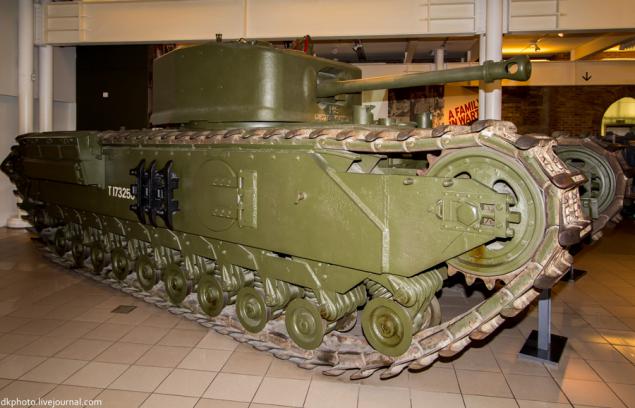
15 US Medium Tank M4, with a light hand of the British was named "Sherman» (Sherman), which is well behind him and stuck, you can call Western T-34. British themselves in the museum's information plate admit that he yielded to his day as the German and Soviet tanks. Nevertheless, all from 1942 to 1946, produced more than 40 thousand. "Sherman" on the scale of production, he said only behind the T-34.
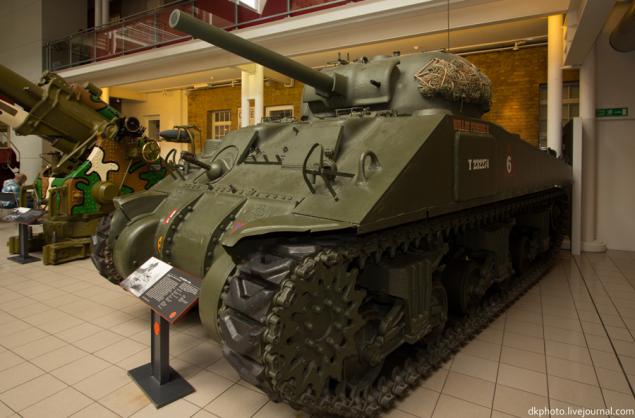
16 Characteristics of the tank over time, improved, in particular this applies to weapons. Exposed in the Museum M4A4 was released in Detroit between July 1942 and September 1943, it is not the most powerful 75-mm gun M3. Later, "Sherman" armed long-barreled guns, but still in a clash with German tanks, the Americans and British as possible tried to go on the defensive and cause the aircraft.
Tamper in M4 was lower than that of the Soviet T-34/85, and the power plant, like M3, was automobile origin.
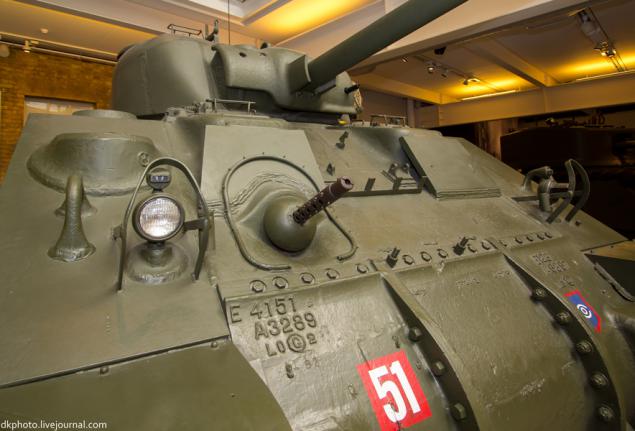
17 formidable opponent of the British (and American and Soviet) tanks - a German tank destroyer "jagdpanther» (Jagdpanther). Its 88 mm gun Pak-43/3 with a barrel length of 71 gauge virtually guaranteed in the case of contact with the destruction of any existing tank. In contrast to the earlier German hasty alterations it was well thought out and well-designed dedicated tank destroyer.
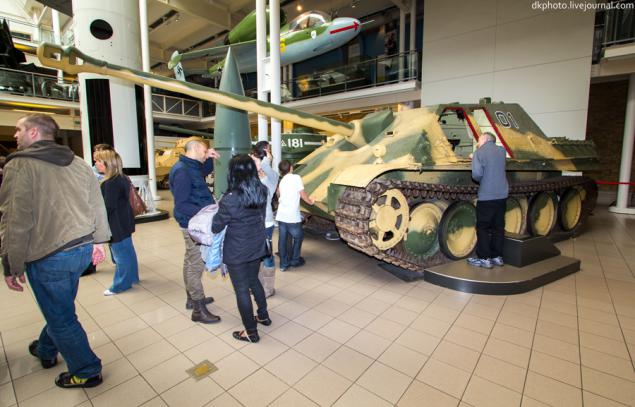
Source:
The museum was conceived as early as 1917 - in the midst of the First World War, to pay tribute to the participants of the grandiose slaughter and home front workers. The opening took place in the summer of 1920 in the Crystal Palace. Then, the museum has several times changed his residence, until in 1936 finally settled in a former Betlemske psychiatric Royal Hospital (which is well known as "Bedlam") on Lambeth Road, which, incidentally, has saved the real palace of the plan was the demolition .
Although the museum was closed to the public since 1940, and another year later was struck by a direct hit of German bombs, the materials on the Second World War, there began to collect almost immediately after it began. Partially renovated museum opened to visitors in 1946 and continued to aggressively create new and new exposure associated with practically every more or less large military conflict, especially if it somehow related to the UK or the members of the British Commonwealth. Do not forget the Cold War, which is dedicated to the former Bedlam than one room.
Photos I have done so much, that the album of the Imperial War Museum will have to beat a dozen pieces. However, we wait and see - if the topic is of particular interest in the cause, the story can always fold. Well, in the first part of the album, I will highlight the theme mainly exposed in the huge main hall of the museum of armored vehicles. Later, through a miniature submarines, missiles and artillery'll move to the air, and then to the trenches of the First World War and to the image of Russian allies, what they depict contemporary British public. Well, we'll see - how the suit will fall. Post, however, still have a hanger, or rather to the main entrance of the museum, which will inevitably have to go through before get the exposure to the tank.
In magnificent building built in the early XIX century visitor encounters a very impressive offshore raspaltsovka 15-inch (381-mm) guns of the century XX.
20 Picchu text. via dkphoto

2 These monsters were designed in 1912 for class battleships "Queen Elizabeth» (Queen Elisabeth), and at that time was the most powerful in the world (then they certainly exceeded). Total such guns was armed with 22 British battleships. The weight of each "baby" is 102 tons, maximum range up to 29 kilometers. Most heavy shell - for the sake of clarity, it is possible to admire on the right - weighs 876 kilograms. The effect of falling into the enemy ship, you can only try to imagine. However, artillery fire at that time are not particularly accurate.
Exposed front of the museum guns served on different ships. What adorns the left, in 1916, was installed in one of four twin towers battleship 'Ramillies »(HMS Ramillies) Class" Revenge »(Revenge, aka Royal Sovereign), which is a further improvement" Queen Elizabeth. " Baptism of fire weapon received after the end of the First World in the relatively little-known second Greco-Turkish War 1919-1922 years. In 1920, during an exacerbation of the conflict between Britain (Allies formally supported the Greeks) and Turkey battleship shelled shore targets in the Sea of Marmara.
The second and last time the gun had a chance to shoot at the enemy in November 1940, mainly in the inconclusive battle with the Italian fleet at Cape Spartivento. Also mentioned are some attacks on targets on land in the same month, but what exactly is it, I have not found. Anyway, next year the gun was dismantled.
Cannon, standing right, fought much longer, though, and began his career in much the same - the same type on board the battleship "Rezolyushin» (HMS Resolution) during the Greco-Turkish War. However, shooting battleship then and did not have to - it is only the sword of Damocles plied the eastern Mediterranean.
In 1938, an instrument was dismantled from the battleship, but with the beginning of World War II, construction was set to monitor "Roberts» (HMS Roberts). And it is here that the work was found! Operation "Torch" (Allied landings in French North Africa), the operation "Husky" (invasion of Sicily), the operation "Avalanche" (the landing at Salerno, Italy) - it was only a prelude to a genuine work during the Allied landings in Normandy. Monitor suppress their fire German coastal battery in Houlgate, I kept shelling the positions of the Wehrmacht at Cannes. Later on November 1, 1944 implements "Roberts" kept landing on the Dutch island (peninsula) Walcheren, shooting a German artillery position near the village of Westkapelle.
Immediately after the war there put up a weapon was dismantled.
His last duty station at the entrance to the Imperial War Museum, these menacing pipe found in 1968.

3 Visit to the museum is free for all - as has become a tradition ever since its opening. The institution is funded primarily by the state. Apparently, the museum (quite justified, I want to mention) is considered an important element of patriotic education. The educational function is realized already located at the entrance kinozalchike where on a big screen showing films about British peacekeepers in different corners of the world. Frankly, although I was interested in references to Iraq and Yugoslavia, to linger at the screen did not - hurried to the main exhibition. Meanwhile, it is curious that the film tells of Tony Blair and the invasion of Iraq, of the Serbs and Albanians ...

4 The most delicious in the museum - it is a multi-storey main exhibition hall where the real military equipment: tanks, self-propelled guns, towed artillery systems, fighter jets, bombers, cruise missiles and ballistic missiles, submarines and other samples of the old martial iron. As I announced above, the story will begin with armored subjects.

5 interesting exhibits - a heavy British tank of the First World War, Mark V (Mk V). Despite the impressive weight of nearly 30 tons, it can not boast of any heavy armor - in this sense it does not exceed, and taking into account angles inferior plane of the body, even the earlier French light tank Renault FT-17. The thickness of the frontal armor of the giant does not exceed 15 mm, which effectively protects only against small arms fire and shrapnel.
The advantage of the heavy tank was then considered his firepower. Mark V in the exposed then modifying "male" ("female" were purely machine-gun armament) could boast two maritime rapid-6-pound guns "Hotchkiss" (caliber 57 mm, barrel length of 40 calibres) in two sponsons and four 8-mm machine guns "Hotchkiss" with air cooling.
The speed of this giant on the highway does not exceed 7-8 km / h and on the road was several times lower, which, coupled with a small reserve is not allowed to use these tanks to develop after the onset of the breakthrough - he usually managed to bring up reserves and to localize the gap .
Tanks Mark V compared to its predecessors, however, considered to be very sophisticated. In part, they were only in May 1918, and the fight went and did in July, that is the end of the war, of the Great War. Exhibited machine here at number 19 and the name 'Devil' serve in the fourth battalion of the Royal Tank Corps. Tank was decommissioned in 1925. The Red Army seized from the white invaders and Mark V poverty were armed at all until 1930, but under the name "Riccardo" by brand engine.

6 For clarity and convenience of visitors to the museum one sponson the tank removed and taken away through a hole in the glass, you can see the interior of the machine. Exceptionally good idea!

7 Mark V crew consisted of eight people, while significant progress was thought that to drive a car could now only one member of the crew - a driver. Prior to that, the British heavy tanks require considerable joint efforts of four people at once: the actual driver, the commander in charge of the brake tracks both sides, as well as two transmissionschikov working for airborne transmission. Coordination of actions hampered the infernal noise of the set in the center of the inner chamber of the engine and propeller unmerciful clang elements, not to mention the work of the weapons. Meanwhile, an internal intercom system in the tanks of the time just was not there. With external communications business situation was also very badly - at short distances using flag signaling and for communication over long distances tried to use carrier pigeons. However, quite unsuccessfully, as the poor bird could not withstand the conditions inside the tank.
Said noise was flowers compared to the high temperature air (during the fight, it rose to 70 degrees) from the heating of the engine, a child of the hot oil and smoke from the cannon shots (to purge the barrel after shooting began only during the Second World War, and then not at all tanks). In such circumstances, the crew often simply ugoral in the midst of battle.
Poor was the observation of the tank - the cracks did not give a good review, but they were aiming arrows of the enemy, and even if the bullet hits nearby, often flew into a spray of molten lead. That is why 80% of all tankers had wounds to the eyes. However, a Mark V viewing device of the driver represented a perforated plate, and somehow protect the eyes.

8 Easy armored Daimler Mk I (Daimler Armoured Car), after some thought, I have also included in the Tank section of the Album. This 7, 5-ton all-wheel drive car was the basis for the armored car and parts of British intelligence during World War II. In the light of it appeared in April 1939, but because of the many technical problems that required fixes her military career really began only in 1941. There were produced 2694 cars Mark I and Mark II.

9 Maximum armor thickness reached 36 mm, and installed a tower on a light tank "Tetrarch" with its relatively good arms (2-pound cannon and 7 62-mm machine gun "Besa") did Daimler Mk I quite dangerous opponent light of German and especially more Italian tanks. However, the creators of the machine more relied on her mobility than security - armored car developed a speed of 80 km / h. The crew consisted of three people.
These armored cars were on different fronts of the Second World War (especially widely used in North Africa), and a long time afterwards. The fate of the exposed specimen caught in a museum only in 1966, is unknown. Damage camouflage corresponds to the first Royal Dragoons during the landing in Sicily in September 1943.

Legendary 10 at the time the average British infantry tank "Matilda» (Matilda II). Famous for it was mainly his colon - forehead 78 mm, 40-65 mm board - armor, which were powerless against the standard German anti-tank guns of the initial period of the war. This quality will bring a lot of trouble Rommel, until he used against tolstobronnyh but slow (15 km / h cross country, no more than 24 - on the highway) and inflexible used British command "Matilda" their small 88-mm anti-aircraft gun Flak 18 / 36/37.
Armament, by the way, was not adequately protected (it is believed that the tank should be able to destroy his own kind at a distance of over 500 meters) - a very weak 40-mm 2-funtovka as those shown above, the armored car.
These tanks are supplied under Lend-Lease and the USSR (900 pieces), but the Red Army did not enjoy great popularity, despite the greater comfort for the crew than the T-34.
Here, "Matilda" is presented in a desert camouflage for North Africa.

11 The average American tank M3A3, produced for the British army and bearing the name "Grant» (Grant). Supplied under Lend-Lease to the USSR, the tank was another unofficial name - BM-6, which stands for "mass grave for six." Do not loved in the Red Army lendlizovkie tanks, as they, in spite of the high culture of production of combat characteristics markedly inferior to the Soviet "classmates».
M3 - is hasty improvisation on the basis of a medium tank M2, produced at the beginning of the war, when the US government realized that the American army has nothing to oppose the German panzer divisions. Placing 75-mm guns in the side sponsons - a tribute to the tanks of World - has hindered the effectiveness of combat vehicle, which in other circumstances would not be carried to the tanks and to the ACS. (However, there was another 37-mm anti-tank gun in the tower, but it had originally been obsolete.) The second was the use of improvised propulsion system of several automobile engines. "Road" approach, however, has allowed American industry very quickly master the production of military equipment.
Despite all its shortcomings, M3 fared well in North Africa in a collision with the German Pz. IV, short-armed 75-mm cannon. Yet tank hopelessly outdated in the summer of 1943, when the Germans began to make extensive use of a new generation of their tanks, including "Tiger» Pz.VI and "Patnery» Pz.V. With the production of M3 was withdrawn, however, only in March 1944.

12 In the absence of the breech gun in the turret, is easy to guess that this modification of the commander, where the 37-mm gun for the exterior masking replaced hoax. In fact, the exhibition at the Museum of the sample served as commander of the machine General (later Field Marshal) Bernard Law Montgomery (Bernard Law Montgomery) (1886-1976), who broke the course of the war in North Africa and defeated one of the most talented German commanders - Erwin Rommel. For the British the battle of El Alamein the fall of 1942 as symbolic for us the battle of Stalingrad, though the magnitude (and significance, perhaps) to compare these battles, of course, impossible.

13 heavy infantry tank "Churchill» (Cherchill) Mark VII - is also a kind greetings from tankostroitelnyh traditions of the First World War. Prime Minister Winston Churchill, known penchant for self-irony, nevertheless said that armored namesake, perhaps, weaknesses, even more than he himself.
Overall it was a pretty typical for the British model - low-speed, highly protected, rather poorly armed. In general, a classic infantry tank, designed to directly support infantry, but not for deep operations, that is created by the deliberately obsolete canons. This is all the more surprising when you consider that the car was designed after the Second World War, when the world has known tremendous efficiency of the German armored spearheads.
Nevertheless, it is a high degree of protection - frontal armor on the modification of Mark VII reached 152 mm - allowed this tank not only to remain in service with the British Army until the end of the war, but also to war in Korea in 1950-1953.

14 Weighing 40, 6 tons, this machine could accelerate faster than 21 km / h. However, the modification of the fighting in north-western Europe, even though it was relatively adequate weapons - a relatively long-barreled 75-mm gun (plus two machine guns Besa), instead of two and six-pound cannon, as in the earlier versions of this tank.
In the picture, by the way, perfectly visible archaic machine design - covering the entire body of the caterpillars hatch between the rollers ...

15 US Medium Tank M4, with a light hand of the British was named "Sherman» (Sherman), which is well behind him and stuck, you can call Western T-34. British themselves in the museum's information plate admit that he yielded to his day as the German and Soviet tanks. Nevertheless, all from 1942 to 1946, produced more than 40 thousand. "Sherman" on the scale of production, he said only behind the T-34.

16 Characteristics of the tank over time, improved, in particular this applies to weapons. Exposed in the Museum M4A4 was released in Detroit between July 1942 and September 1943, it is not the most powerful 75-mm gun M3. Later, "Sherman" armed long-barreled guns, but still in a clash with German tanks, the Americans and British as possible tried to go on the defensive and cause the aircraft.
Tamper in M4 was lower than that of the Soviet T-34/85, and the power plant, like M3, was automobile origin.

17 formidable opponent of the British (and American and Soviet) tanks - a German tank destroyer "jagdpanther» (Jagdpanther). Its 88 mm gun Pak-43/3 with a barrel length of 71 gauge virtually guaranteed in the case of contact with the destruction of any existing tank. In contrast to the earlier German hasty alterations it was well thought out and well-designed dedicated tank destroyer.

Source:


